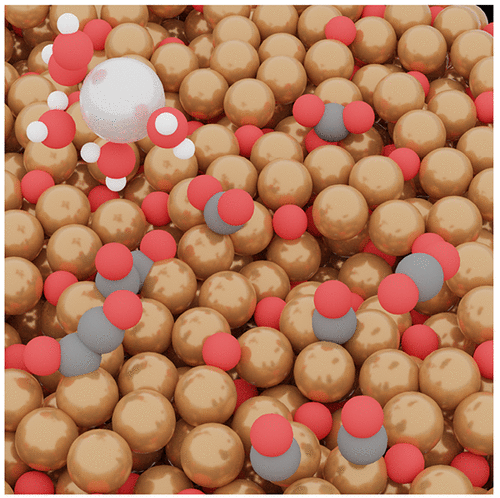当前位置:
X-MOL 学术
›
Chem. Rev.
›
论文详情
Our official English website, www.x-mol.net, welcomes your feedback! (Note: you will need to create a separate account there.)
Modeling Operando Electrochemical CO2 Reduction
Chemical Reviews ( IF 62.1 ) Pub Date : 2022-04-27 , DOI: 10.1021/acs.chemrev.1c00690 Federico Dattila 1 , Ranga Rohit Seemakurthi 1 , Yecheng Zhou 2 , Núria López 1
Chemical Reviews ( IF 62.1 ) Pub Date : 2022-04-27 , DOI: 10.1021/acs.chemrev.1c00690 Federico Dattila 1 , Ranga Rohit Seemakurthi 1 , Yecheng Zhou 2 , Núria López 1
Affiliation

|
Since the seminal works on the application of density functional theory and the computational hydrogen electrode to electrochemical CO2 reduction (eCO2R) and hydrogen evolution (HER), the modeling of both reactions has quickly evolved for the last two decades. Formulation of thermodynamic and kinetic linear scaling relationships for key intermediates on crystalline materials have led to the definition of activity volcano plots, overpotential diagrams, and full exploitation of these theoretical outcomes at laboratory scale. However, recent studies hint at the role of morphological changes and short-lived intermediates in ruling the catalytic performance under operating conditions, further raising the bar for the modeling of electrocatalytic systems. Here, we highlight some novel methodological approaches employed to address eCO2R and HER reactions. Moving from the atomic scale to the bulk electrolyte, we first show how ab initio and machine learning methodologies can partially reproduce surface reconstruction under operation, thus identifying active sites and reaction mechanisms if coupled with microkinetic modeling. Later, we introduce the potential of density functional theory and machine learning to interpret data from Operando spectroelectrochemical techniques, such as Raman spectroscopy and extended X-ray absorption fine structure characterization. Next, we review the role of electrolyte and mass transport effects. Finally, we suggest further challenges for computational modeling in the near future as well as our perspective on the directions to follow.
中文翻译:

模拟 Operando 电化学 CO2 还原
自从密度泛函理论和计算氢电极在电化学 CO 2还原(eCO 2R) 和析氢 (HER),这两种反应的建模在过去二十年中迅速发展。结晶材料上关键中间体的热力学和动力学线性比例关系的制定导致了活动火山图、过电位图的定义,并在实验室规模上充分利用了这些理论成果。然而,最近的研究暗示了形态变化和短寿命中间体在控制操作条件下的催化性能方面的作用,进一步提高了电催化系统建模的门槛。在这里,我们重点介绍了一些用于解决 eCO 2 R 和 HER 反应的新方法。从原子尺度转移到体电解质,我们首先展示如何从头开始机器学习方法可以部分再现操作下的表面重建,从而在与微动力学建模相结合的情况下识别活性位点和反应机制。随后,我们介绍了密度泛函理论和机器学习在解释Operando 光谱电化学技术(如拉曼光谱和扩展 X 射线吸收精细结构表征)数据方面的潜力。接下来,我们回顾了电解质和质量传输效应的作用。最后,我们建议在不久的将来计算建模的进一步挑战以及我们对未来方向的看法。
更新日期:2022-04-27
中文翻译:

模拟 Operando 电化学 CO2 还原
自从密度泛函理论和计算氢电极在电化学 CO 2还原(eCO 2R) 和析氢 (HER),这两种反应的建模在过去二十年中迅速发展。结晶材料上关键中间体的热力学和动力学线性比例关系的制定导致了活动火山图、过电位图的定义,并在实验室规模上充分利用了这些理论成果。然而,最近的研究暗示了形态变化和短寿命中间体在控制操作条件下的催化性能方面的作用,进一步提高了电催化系统建模的门槛。在这里,我们重点介绍了一些用于解决 eCO 2 R 和 HER 反应的新方法。从原子尺度转移到体电解质,我们首先展示如何从头开始机器学习方法可以部分再现操作下的表面重建,从而在与微动力学建模相结合的情况下识别活性位点和反应机制。随后,我们介绍了密度泛函理论和机器学习在解释Operando 光谱电化学技术(如拉曼光谱和扩展 X 射线吸收精细结构表征)数据方面的潜力。接下来,我们回顾了电解质和质量传输效应的作用。最后,我们建议在不久的将来计算建模的进一步挑战以及我们对未来方向的看法。

























 京公网安备 11010802027423号
京公网安备 11010802027423号